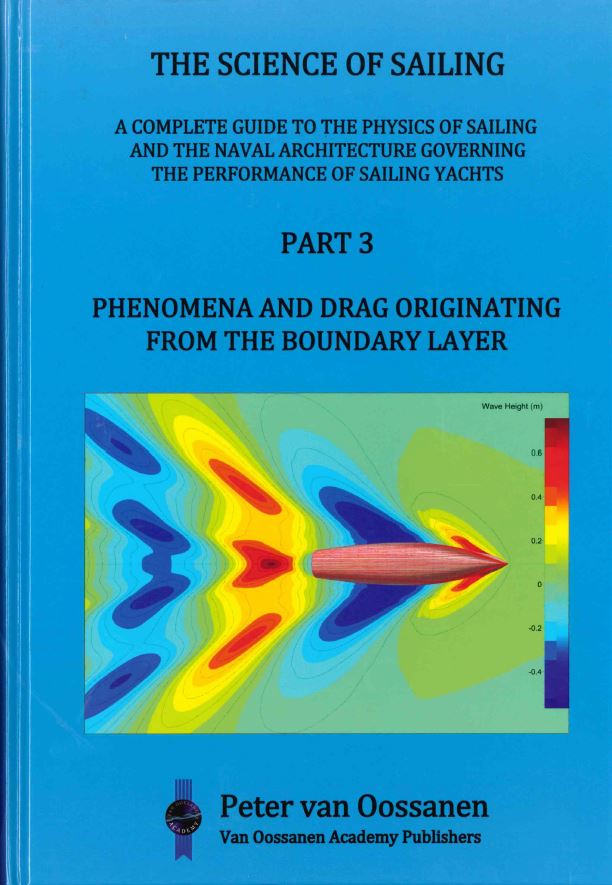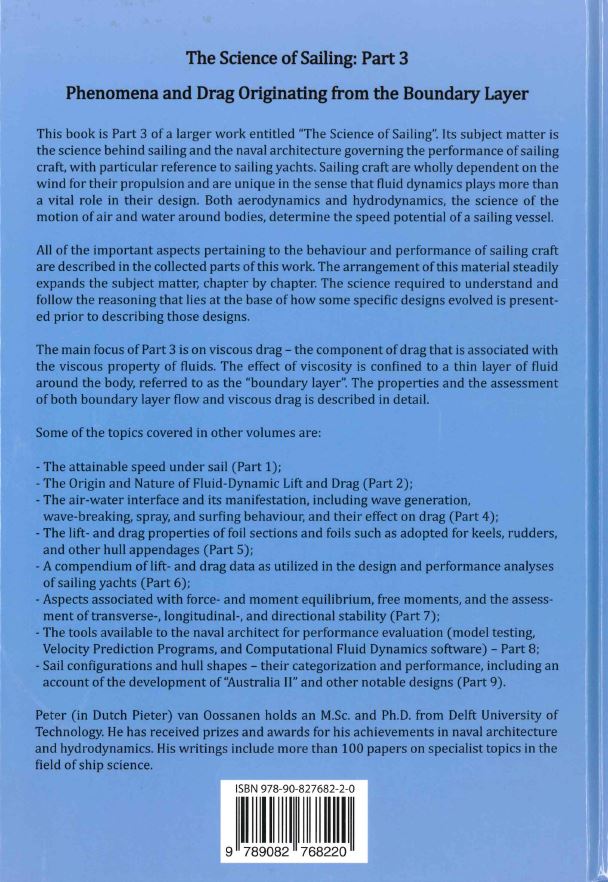Inspiration
(note from Peter)
Part 3 of the series, ‘The Science of Sailing’, is dedicated to the topic of viscous drag. Viscous drag is the prime component of hydrodynamic drag for most sailing craft (and most other boats and ships). In Part 2, I explained that the performance of boats, yachts, and ships is particularly governed by the forces opposing forward motion (more so than in the case of aircraft), and the key to solving ship-oriented performance issues requires in-depth knowledge concerning the optimum shape of hulls and hull appendages in relation to their drag characteristics. I therefore decided to dedicate both Parts 3 and 4 to aspects associated with drag – in Part 3, entitled, ‘Phenomena and Drag Originating from the Boundary Layer’, aspects associated with the drag due to the viscosity of the medium (air and water), and in Part 4, aspects associated with the drag caused by the fluidity of the air-water interface. I want to stress that the assessment of drag is still surrounded by notions and assumptions that are at best only partially correct – notwithstanding the fact that the study of this subject has been ongoing since William Froude presented his paper entitled: ‘The Fundamental Principles which Govern the Behaviour of Fluids, with Special Reference to the Resistance of Ships’, in 1875.
The drag that occurs on a body away from the water surface, such as on a submarine at some depth, originates from the boundary layer the thin layer of fluid flow around a body in which the velocity of the flow is decelerated to zero (relative to the velocity of the body) at the body surface. This component of drag is referred to as viscous drag. Fluid viscosity is here manifest to a significant degree, opposing this deceleration, causing significant shear forces between adjacent layers of the fluid, and a skin friction force on the surface of the body that varies along its length. The summation of this skin friction force along the body leads to its friction drag, which, for most vessels, is the most important component of total drag. Aspects of the boundary layer that are of importance for the understanding of viscous drag are considered in detail.
Viscous drag is composed of two primary components: friction drag and viscous pressure drag. Friction drag is generally assessed by expressions based on the friction drag of smooth flat plates, that are semi-empirical in nature. The friction drag obtained from a selection of these expressions varies by 11.9% at a low Reynolds number, and as much as 18.3% at a high Reynolds number. I have addressed this disturbing state of affairs by adopting the results of RANS CFD calculations for five geometrically similar hulls of different length, each for 6 values of the Froude number, and identified the flat plate friction drag formulation that displays the same trend with Reynolds number as that found from these CFD calculations. This study of the friction drag of the three-dimensional hull of typical sailing yachts (and many other slender hull forms) revealed that, generally, it is less than that of the equivalent flat plate (the plate with the same length and wetted area as the subject hull).
Another aspect that has needed examination for some time is the practice of adopting a form factor to account for the excess viscous drag of a hull relative to the friction drag of the equivalent flat plate. Viscous pressure drag is an important part of this excess viscous drag. The present-day method for determining the value of this form factor is based on the limiting value of the total drag-to-flat plate friction drag ratio, as the Froude number approaches zero. There is no scientific basis for this practice, but it is widely utilized because of the ease with which an estimate is obtained from the value of this form factor for the excess viscous drag. Viscous pressure drag consists of two parts. The first of these is the Reynolds-dependent part which is indeed found on considering the limit of the total drag-to-friction drag ratio, which part conforms to the viscous pressure drag as found in wind tunnels when testing foil sections and such. The second part is the viscous pressure drag associated with wave-making. This last part, in contemporary ship hydrodynamics, is all but forgotten.
By again adopting the results of a large series of CFD results, for both the RANS and the Euler options of the CFD code, the magnitude of both components of viscous pressure drag were identified for the same series of sailing yacht hulls referred to earlier. This involved the comparison of the pressure drag as found from the RANS CFD calculations (for the case when viscosity plays its part in resolving the flow around the hull) with the pressure drag as obtained from the ‘Euler’ calculations (for the case when viscosity is set equal to zero). The result of subtracting the Euler result from the RANS result defines the viscous pressure drag. This component of viscous drag was found to be dominantly negative, quickly annulling the positive component of viscous pressure drag found for the zero Froude number condition. Comparison of the waves generated in both cases reveals that fluid viscosity causes a reduction in wave elevation. The resulting level of total viscous drag is thus lower than that generally assumed, and the wave drag (equal to the pressure drag as found from the Euler calculations) higher than contemporary methods lead us to believe. These findings have particular consequences for the method in use today for the scaling of drag between hulls of different size. The most important aspect of this scaling procedure is the level of drag assigned as viscous (Reynolds number dependent) and non-viscous (Froude number dependent) because each is scaled differently. The use of a form factor based on the limiting Froude condition clearly leads to errors. Viscous drag rarely exceeds that of the friction drag of the equivalent flat plate, unless the hull exhibits flow separation.

Blurb text
This book is Part 3 of a larger work entitled, ‘The Science of Sailing’. Its subject is the science behind sailing and the naval architecture governing the performance of sailing craft, with particular reference to sailing yachts. Sailing craft are wholly dependent on the wind for their propulsion and are unique in the sense that fluid dynamics plays more than a vital role in their design. Both aerodynamics and hydrodynamics, the science of the motion of air and water around bodies, determine the speed potential of a sailing vessel.
All the important aspects pertaining to the behaviour and performance of sailing craft are described in the collected parts of this work. The arrangement of this material steadily expands the subject, chapter by chapter. The science required to understand and follow the reasoning that lies at the base of how some specific designs evolved is presented before describing those designs.
The main focus of Part 3, entitled, ‘Phenomena and Drag Originating from the Boundary Layer”, is on viscous drag – the component of drag that is associated with the viscous property of fluids. The effect of viscosity is confined to a thin layer of fluid around the body, referred to as the “boundary layer”. The properties and the assessment of both boundary layer flow and viscous drag is described in detail.
Some of the topics covered in other volumes are:
- The attainable speed under sail (Part 1);
- The Origin and Nature of Fluid-Dynamic Lift and Drag (Part 2);
- The air-water interface and its manifestation, including wave generation, wave-breaking, spray, and surfing behaviour, and their effect on drag (Part 4);
- The lift- and drag properties of foil sections and foils such as adopted for keels, rudders, and other hull appendages (Part 5);
- A compendium of lift- and drag data as utilized in the design and performance analyses of sailing yachts (Part 6);
- Aspects associated with force- and moment equilibrium, free moments, and the assessment of transverse-, longitudinal-, and directional stability (Part 7);
- The tools available to the naval architect for performance evaluation (model testing, Velocity Prediction Programs, and Computational Fluid Dynamics software) – Part 8;
- Sail configurations and hull shapes – their categorization and performance, including an account of the development of “Australia II” and other notable designs (Part 9).
Peter (in Dutch Pieter) van Oossanen holds an M.Sc. and Ph.D. from Delft University of Technology. He has received prizes and awards for his achievements in naval architecture and hydrodynamics. His writings include more than 100 papers on specialist topics in the field of ship science.

Purchase information
The book is published by Van Oossanen Academy Publishers, and produced by Buijten & Schipperheijn b.v. in Amsterdam. It has a hard cover. The book comprises 140 pages. Its ISBN number is 978-90-827682-2-0. The book is sold by all major bookshops. It can also be ordered directly from Van Oossanen Academy Publishers. The following link is provided for that purpose.